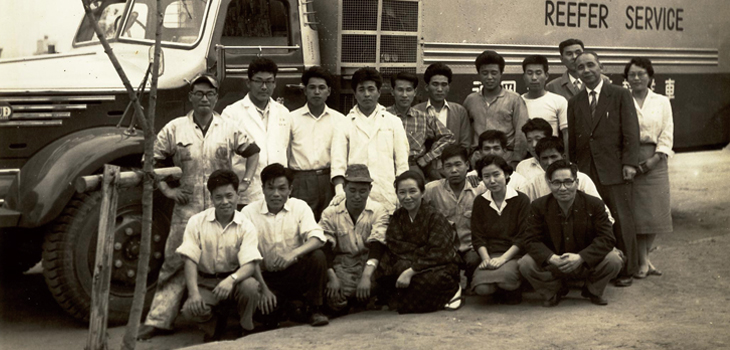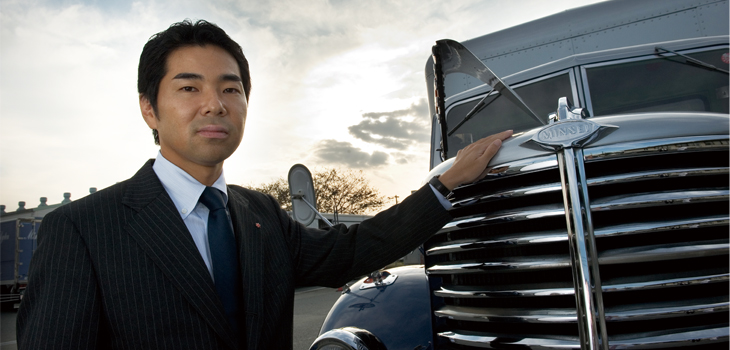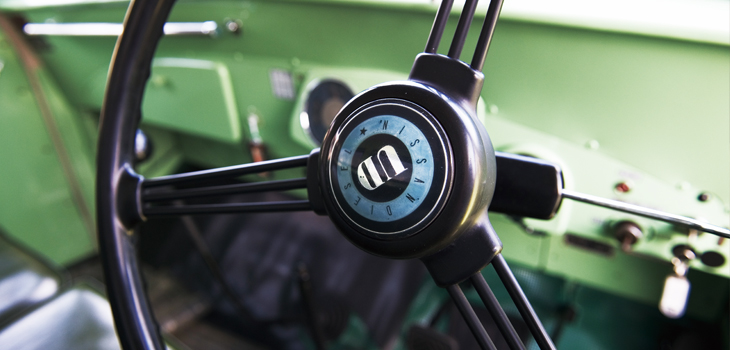A Fukuoka family business took a Minsei Diesel (predecessor to UD Trucks) truck, added a refrigeration unit, and opened up a whole new era for transport and cool storage in Japan
Japan is at the cutting edge of cold-chain technology—the skills needed for supply chains that keep products within a certain, usually cold, temperature range. The nation’s government has long worked with Unicef to improve cold-chain infrastructure in the developing world, something essential for effective immunization programs. But what is the root of Japanese expertise in keeping things cool?
It all started in Fukuoka with an enterprising woman and a truck made by UD Trucks’ predecessor, Minsei Diesel Industries.

The original truck, and the Fukuokaunyu team, in the early 1960s
Shizu Torisu was born in Nagasaki Prefecture in 1909. At 24, she married Kotaro Tominaga, whose family business was amimoto—a fishing enterprise. The couple moved to Fukuoka in hopes of tapping a larger consumer market. But hopes soon took a backseat to the harsh realities of the war years. It was during that time that Kotaro Tominaga succumbed to illness.
“Shizu was left with the amimoto business,” says Taisuke Tominaga, her grandson. “And she had to continue it. But fishing is unstable: it depends on the weather, or even luck in a given year. So you look for ways to expand, and it just happens that our family decided to go into transport.”
In 1956, Mrs. Tominaga founded Fukuokaunyu Co., Ltd. (combining the city/prefecture name with unyu, meaning “transport”). Little did she know that, in partnership with Minsei Diesel and another Fukuoka firm called Yano Special Purpose Vehicle Co., Ltd., she was about to embark on a journey that would dramatically change Japan.
“It was 1957,” says Mr. Tominaga, who became Fukuokaunyu’s president and CEO earlier this year. He’s speaking in a meeting room at one of the company’s offices, the late afternoon sun peeking through the blinds. “The Occupation was over, but the US bases remained. The military was delivering fresh food between bases on its own. But that year they decided to outsource the task to a local company.”
There was just one problem: Refrigerated transport didn’t exist in Japan. “The military had connections with Japanese delivery companies, which it used for normal parcels,” Mr. Tominaga continues. “Yet when it approached these companies about chilled transport, they declined the opportunity.” Mrs. Tominaga accepted. And this is where Yano and Minsei Diesel entered the picture. Fukuokaunyu needed a refrigerated box and a truck capable of carrying it. Mr. Tominaga suggests that, as fellow Fukuoka business owners, his grandmother and Yano founder Koichi Yano made natural allies. They agreed to tackle the project together, with Mr. Yano’s firm taking charge of the refrigeration system. Minsei Diesel, meanwhile, was able to provide 7.5- to 8-ton trucks, which Mr. Tominaga notes were large for the time. The stakes were high for everyone involved. “If they failed in building the truck,” Mr. Tominaga stresses, “Fukuokaunyu could have gone out of business. Someone at Minsei Diesel said to our company, ‘This could be suicide for both of us.’” That concern was not enough to stop the trio from pressing ahead with a process that resembled assembling a puzzle—without being quite sure what it was supposed to look like. The refrigeration compressor proved the most vexing. “You would think,” Mr. Tominaga says, “that if the US had compressors, it would have simply been a matter of importing them. Things were not so straightforward back then.” By late 1958, they had created a refrigerated truck, but they had not yet ironed out all the compressor issues. “Finally, they found a solution,” Mr. Tominaga says. “They managed to acquire old US military compressors.”

The original Minsei Diesel badge
They had been uncertain about what they should do, but then received a helping hand from the US military. The US forces had a number of old refrigeration units destined for scrap, but kindly gave Fukuokaunyu one compressor that was still useable.
The compressor was not the only roadblock. Another was the Transport Bureau’s reluctance to register the Minsei-Yano refrigerated trucks, which were anything but standard. Yet Mrs. Tominaga managed to persuade the bureau, and Fukuokaunyu Reefer Service—a name suggested by a US commander—was born.
Soon, the Japanese government would embrace chilled transport wholeheartedly. In 1965, the Science and Technology Agency announced its intention to promote the cold chain. By 1967, the Reefer Service had a fleet of 120 trucks.
“This technology drastically changed the economy,” Mr. Tominaga says. “The combination of cold transport and the spread of home refrigerators definitely changed the food business and the Japanese diet.” Call it a kitchen revolution. Fast-forward to the present day, and Fukuokaunyu not only offers refrigerated service, it specializes in it. Using a proprietary computer system at bases dotted around the country, the firm can deliver everything from food to medical supplies, maintained at precise temperature zones. “It’s not all about the technology,” Mr. Tominaga stresses. “It’s how you use it. Say you’re delivering a box. It’s no good if the box is damaged, even if what’s inside is fine. That has nothing to do with temperature, but I think this illustrates the Japanese approach to transport.” Fukuokaunyu is now in the process of building up its collection of UD trucks, with 28 currently on the road. Just as the companies are bound together by history, they’re heading into the future together.
The transporter and the truck maker further cemented their bond in the run-up to Fukuokaunyu’s 50th anniversary in 2006, when UD Trucks was still Nissan Diesel. “To celebrate the big milestone, we asked Nissan Diesel to rebuild one of the original refrigerated trucks,” Mr. Tominaga says.The first step was to find a Minsei T80 chassis. “Even if Nissan Diesel found one, there was no guarantee the owner would sell it,” he recalls. “The first one they found, the owner refused to part with it, since it’s a collector’s item. The second one would have been too hard to restore.” Nissan Diesel searched for about a year before hitting the jackpot in Hiroshima. Even then, Mr. Tominaga says, “The Hiroshima company only agreed to sell us the T80 because it had two!” Mr. Tominaga is full of praise for Nissan Diesel’s restoration effort. “It was like a skill Olympics for the workers,” he says. “There were holes in the cabin. It was in pretty poor condition. “ But the team at the company did a Herculean effort, he says, to return the battered truck to a like-new condition.

The UD mark is there as well, on the truck’s steering wheel
Using blueprints, Yano Special Purpose Vehicle pitched in and rebuilt its FB-7 refrigerated compartment. The result was a pristine, drivable replica truck now housed in a massive glass display case outside Fukuokaunyu’s office. Although 2006 was a festive year for Fukuokaunyu, it was also a sad one. That May, Shizu Tominaga passed away at 97. Mr. Tominaga tells of a rather fitting coincidence: Nissan Diesel and Yano Special Vehicle finished the replica that June, one day before Fukuokaunyu was to hold a memorial ceremony for the founder. “We had the truck there for the ceremony,” he says. “A lot of people from the old days came, so we wanted them to see it.”
More recently, Fukuokaunyu, Minsei Diesel and Yano Special Purpose Vehicle officially entered the annals of Japanese innovation together. On Sept. 11, 2012, the National Museum of Nature and Science registered the first refrigerated truck as an Essential Historical Material for Science and Technology, alongside world-changing inventions like the Sony Walkman. The museum’s pamphlet dates the chassis to 1961 and the FB-7 to 1960.
The question remains: What made Mrs. Tominaga take up a challenge others saw as too daunting?
Mr. Tominaga takes a moment to contemplate the question. “It’s difficult to say exactly why she did it. At the time she had a child, my father, who was in school in Tokyo. She was the president, but she was also a mother. And as a mom, she thought about delivering fresh food to her son. I think that was one reason.” Another factor seems to have been her visit to a US base, where she saw a refrigerator for the first time. “I believe her gut instinct told her this would benefit Japanese society.” Thus, Mrs. Tominaga’s vision, Minsei’s chassis and Yano’s refrigerated box combined to create the first link in Japan’s cold chain. And now those links are stretching abroad and benefiting global society as well.
“I believe Shizu’s gut instinct told her this would benefit Japanese society“
